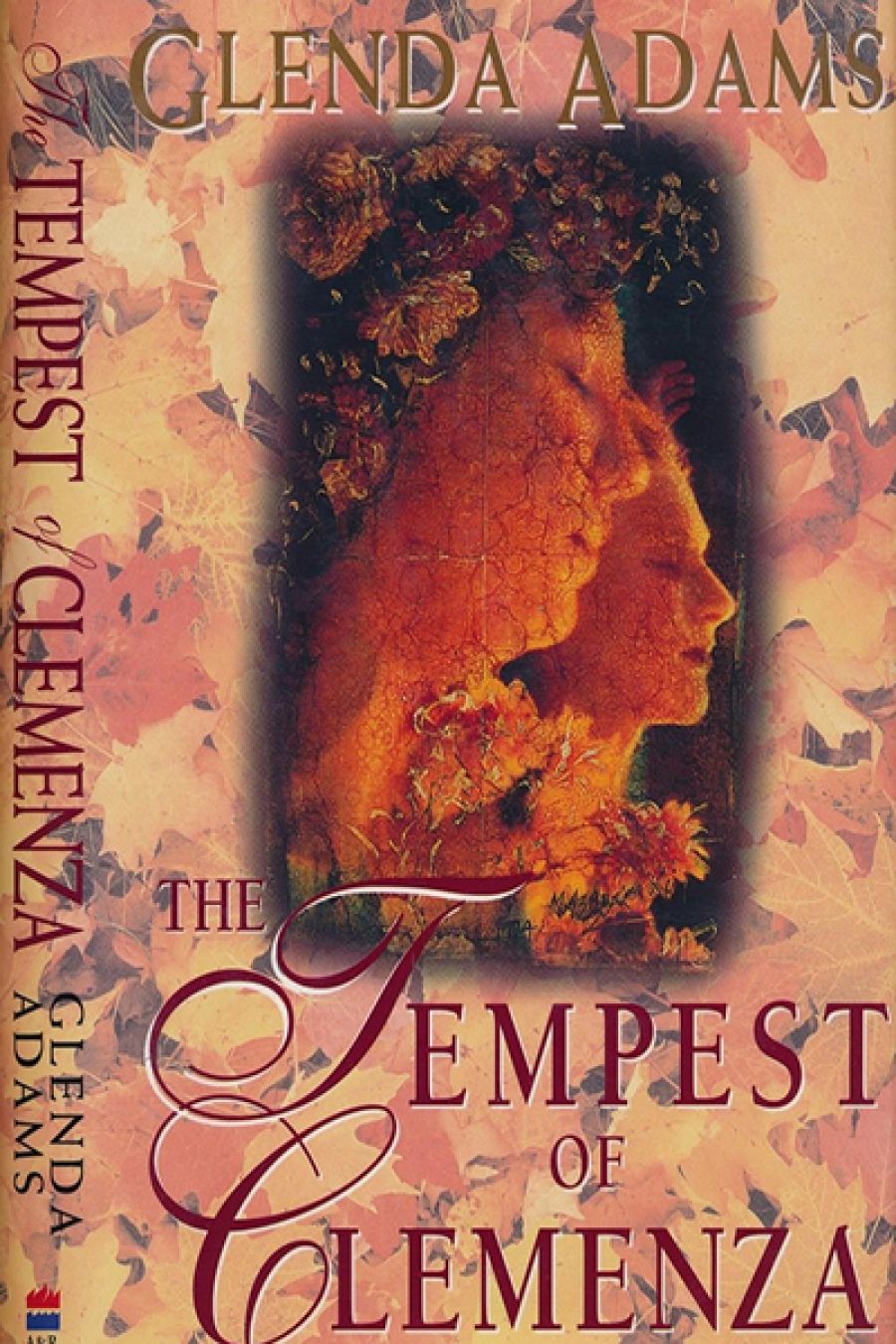
- Free Article: No
- Contents Category: Fiction
- Custom Article Title: Adams' Gothic
- Review Article: Yes
- Article Title: Adams' Gothic
- Online Only: No
- Custom Highlight Text:
It is always a pleasure to read Glenda Adams, a most accomplished and stylish writer. At its best her work displays a natural and unassuming flow, masking artistry of a high order. Admirers of her earlier books will find many familiar concerns in The Tempest of Clemenza; they will also discover her striking out in new directions in a bold and adventurous undertaking.
- Book 1 Title: The Tempest of Clemenza
- Book 1 Biblio: Angus and Robertson, $24.95 hb, 299 pp
- Book 1 Cover Small (400 x 600):

- Book 1 Cover (800 x 1200):

Among the most appealing sections of the new novel are the extended episodes set in the Sydney of 1956, that recent, very ordinary world which seems to grow more and more exotic with the passing of each year. As in her previous novel Longleg, Adams recreates the flavour, indeed the texture, of those decades with simple but highly effective touches. Most notably, perhaps, she contrives to make her characters seem natural inhabitants of a world where television was unknown, where toast-rack trams still snaked all over the city, where young people’s lives were governed by rigid and seldom questioned codes of conduct, and where it was considered somewhat improper for married women to earn a living.
A particular strength of these pages is that they steer a confident path between the ever-present dangers of nostalgia and condescension. Adams captures beautifully the life most young people led in those days – summer holidays at places like Avoca Beach, at a time when it was still possible to buy a block of land and put a shack on it; holding hands in the back stalls of one of the extravagant picture-palaces; not being game enough to order anything other than Wiener Schnitzel in a Chinese restaurant; making elaborate preparations for dances and picnics; and becoming aware that beyond such comfortable ordinariness lay a menacing and ambiguous world.
The menace is captured with skilful tact: Suez and the Russian invasion of Hungary provide a disturbing counterpoint to the lives of people who are still able to think of themselves as inhabiting an isolated world, immune from the threatening dangers of what lies beyond. The one character in these sections of The Tempest of Clemenza who regards both the imminent arrival of television and the military adventures of the great powers with equal alarm and distress is seen by others – his daughter and her friend Cornelia, the narrator of these parts of the novel, for instance – as something of an eccentric, an academic given to exaggeration and self-dramatising.
These episodes of the novel are balanced against a less detailed but equally compelling picture of a different world. The centre of the book’s elaborate structure is occupied by a few August days in Vermont, the last days of summer, when the fierce autumn storms of North America are already gathering around a lakeside house where Abel lives with her thirteen-year-old daughter the Clemenza of the title.
Adams obviously knows the north-east of the United States very well and is therefore to evoke its physical and social characteristics with deft economy. But the framing device in The Tempest of Clemenza is distinguished by another notable quality: the first page tells us that the day around which the novel’s exploration of the past is constructed is the last day of Clemenza’s life. Dying children furnish notorious traps for even the most accomplished writers – heretical though it will no doubt sound, Dickens seems to me to have been a notorious offender, nowhere more so, perhaps, than in Bleak House. Adams, by contrast, is a model of restraint; and, more than that, one of her major achievements is the way in which she combines Clemenza’s very ordinary teenage liveliness with the wistful resignation of one who knows that soon she must die.
There are, accordingly, many fine things here, much that will absorb and enthral. Nevertheless, while impressed by the skill and sensitivity evident throughout this elaborate novel, I found myself troubled by the less-than-happy consequences of Adam’s bold narrative leaps and elisions.
The Tempest of Clemenza is an essay in the currently fashionable mode of the gothic. This is evident both from the novel’s structure and its atmospherics. In the opening pages we learn that Abel, Clemenza’s mother, who had fled from Australia with her daughter for reasons not disclosed until the closing section, finds a sheaf of papers among a job-lot of books she had bought in a shop called ‘The Haunted Mansion’. The manuscript is the diary a teenager called Cornelia Benn kept when she was living in a house in a northern suburb of Sydney which resembles suspiciously the house where Abel had lived with Clemenza, her husband Vick (a Joyce scholar) and his two sons Stephen and Beck – of course.
As Abel reads further and further into Cornelia’s diary of 1956, she discovers extraordinary congruences between herself and the schoolgirl whose paper shave unaccountably fetched up in Vermont. All this is very cleverly done: episodes reflect each other in an ingenious fashion – as, for instance, where a picnic in the Vermont woods described in the opening section proves to be a mirror-image of the event which causes Abel to flee from Australia. In some ways, indeed, the novel is a complicated gothic thriller, and it caters more than adequately for the ‘What happened?’ syndrome.
But that, precisely, is the trouble. The extravagant mirrorings, coincidences, stories-within-stories (including Cornelia’s not very absorbing attempt at a teenage adventure-cum-mystery novel) sit uneasily with the appealing naturalism, and indeed truth, of Adams’ exploration of a vanished world and her presentation of the touching intimacy that develops between Abel and Clemenza in what both suspect might be the girl’s last days.
It would be unfair to Adams and her readers to say more about the novel’s contents. My reluctance to reveal further details indicates, however, how thoroughly Adams has embraced a genre largely reliant on narrative tension. Many will, no doubt, enjoy the book precisely because of that. For me, though, it is those characteristics that render The Tempest of Clemenza less satisfactory. All too often they get in the way of so much that is fine and admirable, none of which, moreover, needs the creaky machinery of the gothic.


Comments powered by CComment